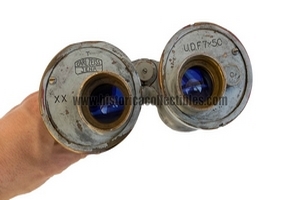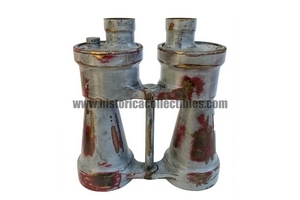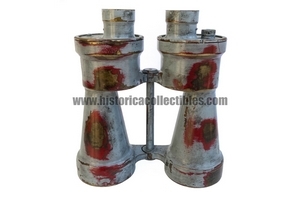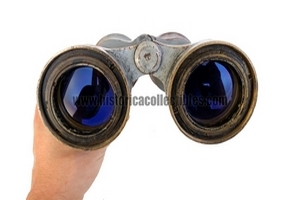Prototype UDF - UZO U-Boot 7x50 Carl Zeiss Kriegsmarine, about 1940
Prototype of Binoculars Mod. U.D.F. - UZO - 7x50 made by Carl Zeiss, circa 1940.
This exact specimen shows unique characteristics not found in any of the UDF versions, such as the shape of the ocular tubes where they should have been housed, the absence of the serial number which has been replaced by "XX" and the presence of 2 screws on the eye plates.
Furthermore, the housing is totally absent which provided for the installation of the bar useful for setting the interpupillary distance and on the right side of the eyepiece, to replace the "Hell or Dunkel" lever there is a small knurled knob which had to trigger some mechanism probably never completed. These binoculars are an experimental model of the Zeiss workshop created exclusively to subject them, through some modifications, to any improvements to be made or a new model of U.D.F., without ever entering the production phase. The only known specimen with these characteristics.
These binoculars are commonly called U.D.F. (Unterwasser Doppel Fernrohr) and belonged to the Kriegsmarine (German War Navy) and were connected via a graduated circular base called (UZO- Unterseewater-Ziel-Optik) with which the ship's course was measured and automatically transmitted to the mechanical control computer placed under the turret exactly in the control room and consequently launched the torpedoes.
The binoculars are constructed entirely of solid bronze, suitable, in the event of a sudden attack and consequent rapid immersion, to withstand pressures of up to 300 meters (30 atmospheres).
The binoculars are equipped with anti-reflection treated lenses (this system was developed and patented on November 1, 1935 by Aleksander Smakula, a member of the Zeiss staff in Jena since 1934).
Carl Zeiss takes its name from its founder, Carl Zeiss, who on November 17, 1846 chose the small city of Jena, in Thuringia, as the location for his precision optical equipment factory. Thanks to the strict quality control that Carl Zeiss imposed on its products, going so far as to personally destroy the microscopes that did not pass the tests, the newborn Zeiss became the official supplier of the University of Jena and received the gold medal of the industrial exhibition in 1861 of Thuringia as the best research instrument produced in Germany, awarded to the Stand I microscope of 1857.
In 1866 the thousandth microscope was produced and the name Zeiss became known throughout European scientific circles. Thanks to studies on the Porro prism, in 1893 Abbe patented double prism binoculars, which accentuated the perception of depth.
The mass production of Zeiss binoculars began in 1894, already at the beginning of the twentieth century more than 30,000 were made, by the beginning of the First World War the figure had risen to 500,000 and, by the end of the Second World War, 2,260,000 were produced binoculars for the civil and military market.
Thanks to studies conducted on the perception of light in low light situations, it was shown that the average dilation of the pupil in an adult is about 7 mm. For this reason, the 7x50 mm model was introduced in 1910 and remained on the market until 1917 with few changes to the materials used. In 1926, following the post-war crisis of the First World War with the Treaty of Versailles which bankrupted many important German companies, Zeiss bought the "C.P. GOERZ" and founded the Zeiss Ikon in 1926.
In 1937 Zeiss had commercial contacts and factories in more than 29 countries around the world. From '33 Zeiss acquired interest from the Nazi regime, which balanced production towards military instruments. It successfully produced binoculars with wide-angle optics for military use, pressure resistant optical systems for U-boats, periscope binoculars for targeting tanks. Furthermore, Zeiss cameras were mounted on the V2s for remote sensing operations of the English coasts.
On November 1, 1935, Zeiss, in the person of Alexander Smakula, patented a process for the treatment of optical glasses with extraordinary results in terms of light transmission. Remained a military secret until 1939, it was adopted on binoculars to reduce ghost images and internal reflections. During the Second World War, there were numerous bombings against the Zeiss factories. Jena was bombed several times by the Allies starting in 1944. Stuttgart was razed to the ground, although the Contessa-Nettel factory suffered little damage. The bombing of Dresden, in addition to devastating the city, also caused considerable damage to the Zeiss Ikon headquarters.
On April 13, 1945, American military forces entered Jena, surprising themselves that the bombing had not caused any significant damage. The main planetarium was in ruins, while the factories remained operational.




